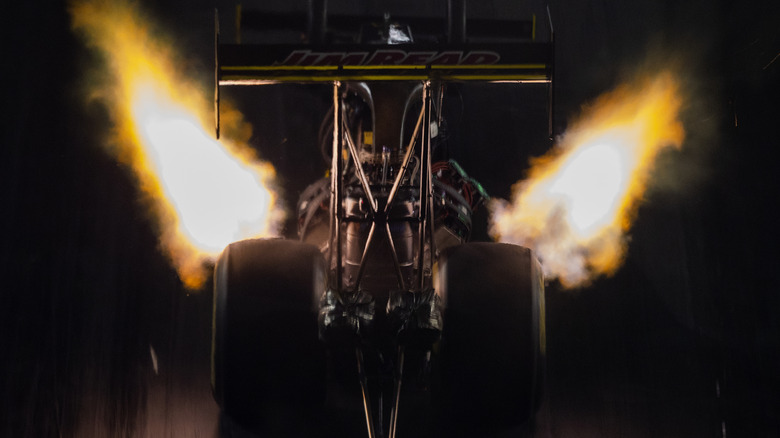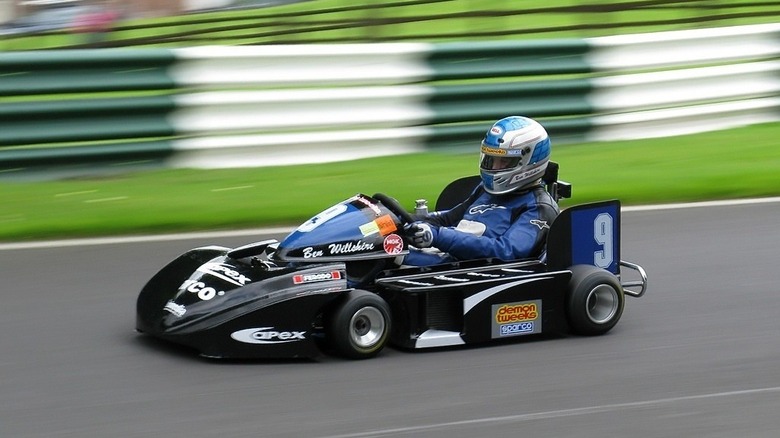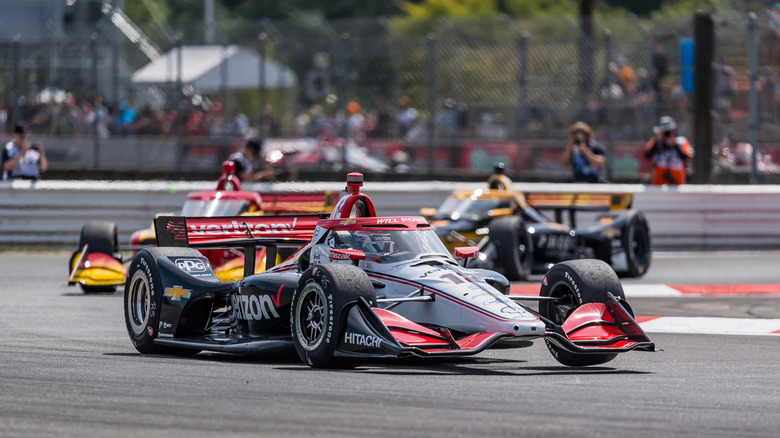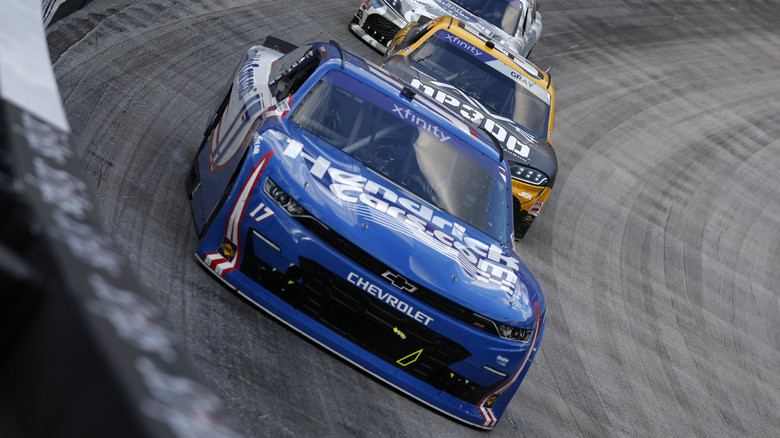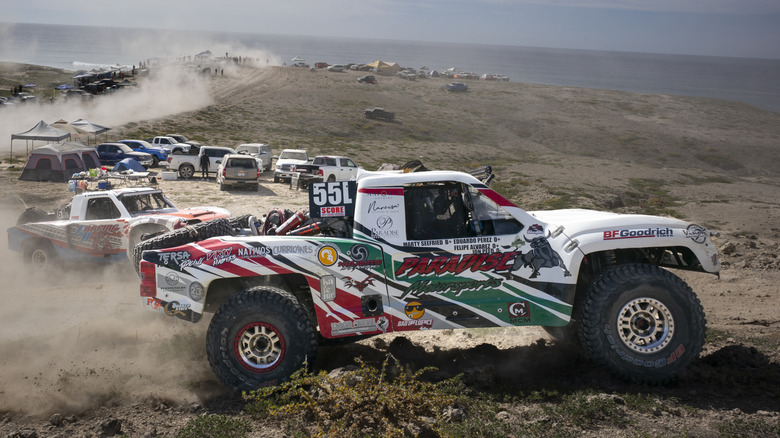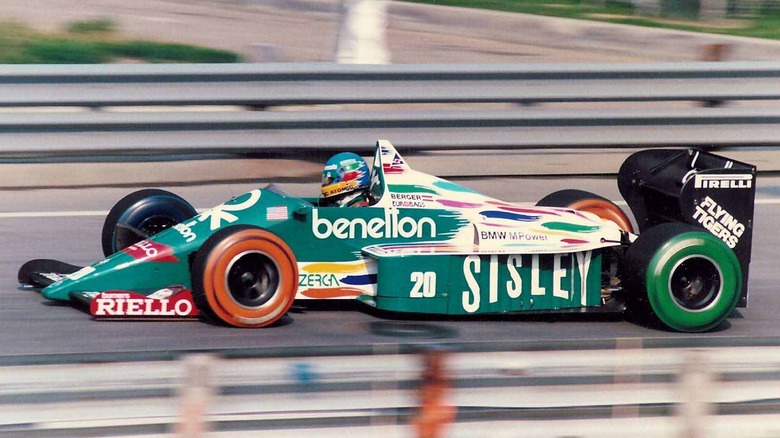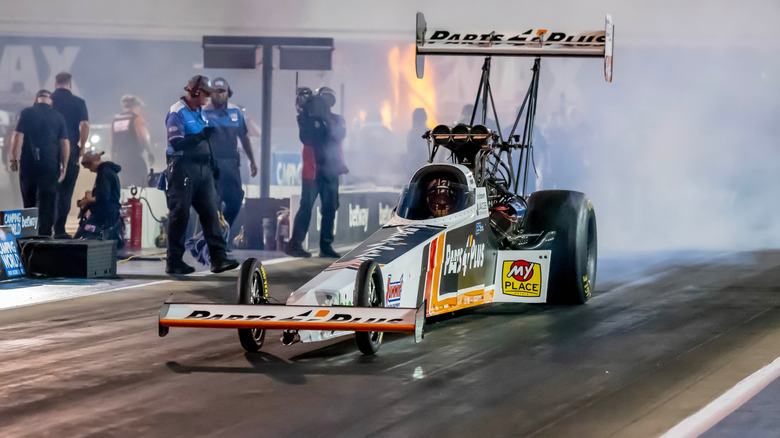8 Of The Most Powerful Engines Ever Put In A Pro Race Car
Nothing hits like a day at the races — the smell of exhaust, the thumping of engines in your chest, the roar of the crowd. Motorsport has delighted generations for as long as there have been motors. Its longevity and popularity are no secret — competition on the race track appeals to something in the DNA of enthusiasts all around the world.
Whether it's the adrenaline rush of rocketing down the drag strip at Pomona, the high-speed excitement of screaming through the streets of Monaco in a Formula 1 car, the rugged adventure of jumping dunes in the Mexican desert, or the intense challenge of a cross-country rally, every race shares a common goal. Speed is king, and the engine, arguably second only to the driver, is the key to victory.
Not all engines are built the same. A Formula car has different needs and performance standards than a rally car. Endurance races like the 24 Hours of Le Mans demand long-term endurance, while a top-fuel dragster operates for mere seconds per race.
Comparing the power difference between professional race cars requires nuance. We will evaluate different types of engines based on the holiest of power metrics: horsepower. However, horsepower only tells one part of the tale.
We will ultimately rank the most powerful engines ever put in a race car by horsepower, but we must also consider the various genres of racing and the performance expectations required by the racing teams that build and operate them.
Karting – Up to 100 hp
Karting might conjur up images of halcyon summer nights at the local amusement park, but it shouldn't. Kart racing is a step (or five) up from the sputtering lawn mower engines you raced between stops at the arcade. Many of today's top Formula drivers begin their careers in karting, including legends of the sport like Lewis Hamilton, Michael Schumacher, Ayrton Senna, and Max Verstappen.
As the first step to the big leagues, kart racing is not for the faint-hearted. The competition is so intense that the Fédération Internationale de l'Automobile (FIA) has established strict rules and regulations for the professional scene. Karts operate under homologation rules and follow the guidelines set by the FIA, including the largest class, Group 4 Superkart, which dictates a cylinder capacity of 250cc.
Superkarts, resembling mini Formula cars, are a sight to behold. The engine sits beside the driver, while the gas tank is nestled between their knees. Superkarts use two-stroke twin-cylinder engines that can produce up to 100 hp. And don't be fooled by their size — these vehicles, including the driver, often weigh less than 500 pounds. This power-to-weight ratio results in a 0-60 mph time of under 2.5 seconds and a top speed of up to 125 mph.
Rally — Turbocharged 2.-1 Liter Audi R5T – 380-600 hp
Rally racing doesn't hit the incredible speeds associated with other types of racing, and that is probably a good thing. Driver Kris Meeke set the record for the fastest rally time in 2016, with an average speed of 78.68 mph. Compared to drag racing or Formula 1 speeds, that doesn't sound crazy, but rally is a wild enough ride as it is. These sedans are positively whipping over off-road terrain like thick woods, gravel, and even snow, at top clip.
Between 1982 and 1986, rally racing experienced a golden era. This was a time when companies were developing cars like the Mitsubishi Lancer Evolution and investing heavily in teams to test them. The top-tier Group B class, with its virtually unrestricted rules, was a playground for competitive racers and deep-pocketed companies.
The Group B period brought some of the fastest rally cars of all time, including the Audi Sport Quattro S1. This legendary car set a world record at Pike's Peak in 1987 by running the 12.43-mile course in 10 minutes, 48 seconds. Under the hood was a turbocharged 2.1-liter five-cylinder bringing 598 hp and 435 lb-ft of torque. Rally cars may never see those numbers again.
The Group B era ended in infamy, when driver Joaquim Santos left the raceway, killing three spectators and injuring dozens of others. The FIA came in with regulations, and power numbers decreased. For 2025, the Fédération Internationale de l'Automobile (FIA) dictated a targeted engine output of 330 hp.
IndyCar — 2.2-liter twin turbo V6 – 700+ hp
At a glance, IndyCar looks a lot like Formula 1. The highest class of open-wheel car racing in the United States, Indy drivers race on a combination of oval, street, and road courses. One of the neat things about IndyCar racing is that it brings strategy, track setup, and driver skill to the forefront by keeping the cars themselves similar.
Unlike Formula 1, where builders construct cars in bids to win constructor titles, every IndyCar team uses the same chassis supplied by Dallara and an essentially identical engine built by Honda or Chevrolet. For 2024, regulations require 2.2-liter twin-turbocharged hybrid V6 engines.
With engines being strictly regulated across the board, picking out singularly powerful examples is tough. In this case, the latest engines are good candidates, with teams coaxing more than 700 hp from a small-displacement V6. Modern IndyCar engines reach 12,000 rpm, and there are no fuel restrictions, so teams can run on E85 if they wish. The competition in IndyCar comes down to which drivers bring their skills to bear the most in a car that the team has set up for that particular course.
NASCAR — Chevrolet 5.8-liter R07.2 — 850 hp
Stock car racing was born with a chip on its shoulder. During the Prohibition era, illegal distillers needed cars that could outrun the law. Turning to their garages, bootleggers modified stock vehicles to be faster than the competition. Prohibition may have ended, but the delight in competing against other cars in a race never did. Today, the National Association for Stock Car Auto Racing (NASCAR) is a government and corporate-sanctioned super sport that draws millions of fans (not to mention dollars) annually.
Today's cars are far from stock. Highly specialized engineering teams pour thousands of work hours into building the beastliest engines possible. But how much power do NASCAR engines have? Despite the cars' full-throated roar and wild speeds around a NASCAR track, 2025 regulations restricted engines to less than 362 cubic inches of displacement — something that would have been considered a small block in the olden days.
Displacement restrictions don't stop teams from generating serious power. One of the most powerful engines of the last twenty years comes from Chevrolet. The company's R07 V8 first debuted in 2007, with the R07.2 arriving in 2017. The updated version was a 5.8-liter (354 cubic inch), 16-valve V8 that traces its lineage all the way back to Chevrolet's first small-block V8s. Unrestricted and naturally aspirated, the R07.2 puts around 850 hp with a redline of 8,500 rpm.
World Endurance Championship — Nissan twin-turbo 3.5-liter V8 – 1,000+ hp
The most powerful engine in the history of the World Endurance Championship happened by accident. The 24 Hours of Le Mans is among history's most revered racing events. It takes everything excellent about motorsport — the competition, the engineering prowess, the courage of the drivers — and adds the spice of a grueling 24-hour race where the winner takes all.
Two premier classes race at Le Mans: LMH and LMDH. There are a lot of technical differences (and similarities) between the two, but the headline is essentially that one is hybrid, one is not, and neither can exceed 698 total hp. However, that wasn't always the case.
Back in 1990, with hybrid and electric vehicles still on the horizon, the most powerful car to ever compete at Le Mans was the Nissan R90CK. Equipped with a twin-turbo 3.5-liter V8, the Nissan prototype was a major contender, with an estimated 700-800 hp under the hood. That is, until it broke.
With driver Mark Blundell behind the wheel of a prototype in a bid to make pole position, the wastegates on his turbos essentially welded themselves shut due to excessive heat. Without the ability to blow off the pressure, the turbocharger just kept boosting the engine, driving Blundell and his car to 238 mph on the famed Mulsanne section. No one knows for sure how much horsepower the malfunctioning engine made but estimates pin it at over 1,000.
Trophy Truck — Dougans Racing Engines 7.7-liter V8 – 1,100 hp
Also known as Baja or trick trucks, trophy trucks elevate the thrill of high-speed off-road racing with endurance races that span several days and cross hundreds of miles of the most challenging terrain on the planet. This is not a sport for the faint-hearted, as any spectator of the Baja 1000 or Dakar Rally can attest.
Trophy trucks, larger and heavier than rally cars, are equipped with advanced suspension systems to tackle the rugged off-road terrain. These systems are designed to absorb the shocks and impacts of jumps, bumps, and stumps. With a weight ranging between 6,500 and 7,500 pounds, these trucks are powered by big-block V8 engines that produce massive amounts of horsepower and noise.
Winning the 2022 Baja event, Luke McMillin's #83 truck was powered by a 555 cubic-inch Chevrolet big-block, built by Kroyer Racing Engines. Unlike many, Kroyer Racing Engines doesn't prioritize horsepower in its engine design. It understands that while horsepower is crucial, torque is even more so, and durability is paramount. Any component that could compromise the engine's ability to finish the race, even if it adds horsepower, is a no-go.
One of the most awe-inspiring features of a trophy truck is its engine. The Dougan Racing Engines 7.7-liter (470 cubic inch) big-block V8 that powered the late Ken Block's Geiser Brothers-built G6 in 2021 is a testament to this. This engine churns out a staggering 1,100 hp, while other trucks boast even more, in the range of 1,200 or 1,300 horses.
Formula 1 — BMW M12/13 – 1,400 hp
It used to be that teams and companies engineered their way to higher numbers, but then those numbers got dangerous. Formula 1 is one category of motorsport where power numbers had to be scaled back from an all-time high.
In 1977, Renault revolutionized F1 by introducing turbocharging to its engine. This innovation sparked a trend, with most teams adopting turbocharged engines. The 1980s saw a field filled with these powerful engines as the FIA continuously adjusted restrictions on displacement and max turbocharging pressure. These changing limits led to the development of the most powerful engines in F1 history.
The BMW M12/13 was an unexpected powerhouse, and widely regarded as the most powerful F1 engine of its era (and by extension, of all time). The 1986 season regulations placed no restrictions on turbocharging pressure or the number of cylinders, allowing the M12/13 to shine. Despite being a 1.5-liter straight-four cylinder, not the typical specifications of a horsepower hog, it managed to astound with its power.
The M12/13 powered the ATS, Benetton, Brabham, and Arrows teams with up to 1,400 hp. That's a pretty insane amount of horses for a tiny engine, and it powered a Benetton B186 to the all-time straight-line speed record for F1 when it clocked 219 mph. The FIA eventually reined in the madness (kind of). Modern Formula 1 engines make about 1,000 hp these days.
Top Fuel Dragster – 10,000-11,000 hp
Drag racing is brash, loud, and singularly focused. It is the least subtle form of racing. No pit lanes, no pole positions, no passing, no hairpins or chicanes. There is one mission: beat the other car to the end of an abused quarter-mile strip of asphalt (the 1,320-foot, quarter-mile race length has been reduced to 1,000 feet in some events, including Top Fuel).
There are multiple levels of drag racing, but the undisputed king is the Top Fuel dragster. The National Hot Rod Association (NHRA) organizes a series of races to see who can field the fastest top-fueler (amongst other categories) each year. You won't find faster straight-line acceleration this side of fighter aircraft.
Top Fuel race teams use V8 engines based loosely on Chrysler's legendary 426 Hemi. And we mean very loosely. NHRA regulations demand a 4.5-inch stroke and 4.187-inch bore, restrict camshafts to smaller than 54 millimeters, and limit displacements to 500 cubic inches. Other than that, teams are largely left to build the engines as they see fit.
The results are staggering. Top Fuel cars regularly make 10,000 hp — over 1,200 hp per cylinder. The cars can suck down 15 gallons or more of fuel on every run. And keep in mind that the run lasts around 3.5 seconds and regularly hits over 320 mph. In February 2025, reigning NHRA Top Fuel champion Artron Brown set a career best with a 3.644-second run at 322.11 mph — all thanks to an 11,000 hp V8 and a big brass pair of steering hands.
